Examining the Political Landscape of the Middle East Post Arab Spring
VerifiedAdded on 2023/01/19
|11
|3452
|52
Essay
AI Summary
This essay examines the enduring impact of the Arab Spring on the Middle East, a region marked by persistent conflict and political instability. It explores how the uprisings of 2011, initially aimed at democratic reform, have led to varied outcomes across countries like Egypt, Yemen, and Syria. The essay highlights the role of religious doctrines in governance, leading to internal conflicts and human rights challenges. It analyzes specific examples, such as the Tahir Square in Egypt, the civil war in Yemen, and the ongoing conflict in Syria, to illustrate the undemocratic nature of the region. The author concludes by emphasizing the importance of a democratic political framework for achieving peace and stability, arguing that the failure to establish such frameworks has perpetuated instability and human suffering in the Middle East. The essay underscores the need for greater respect for human rights and freedoms to foster lasting change in the region.
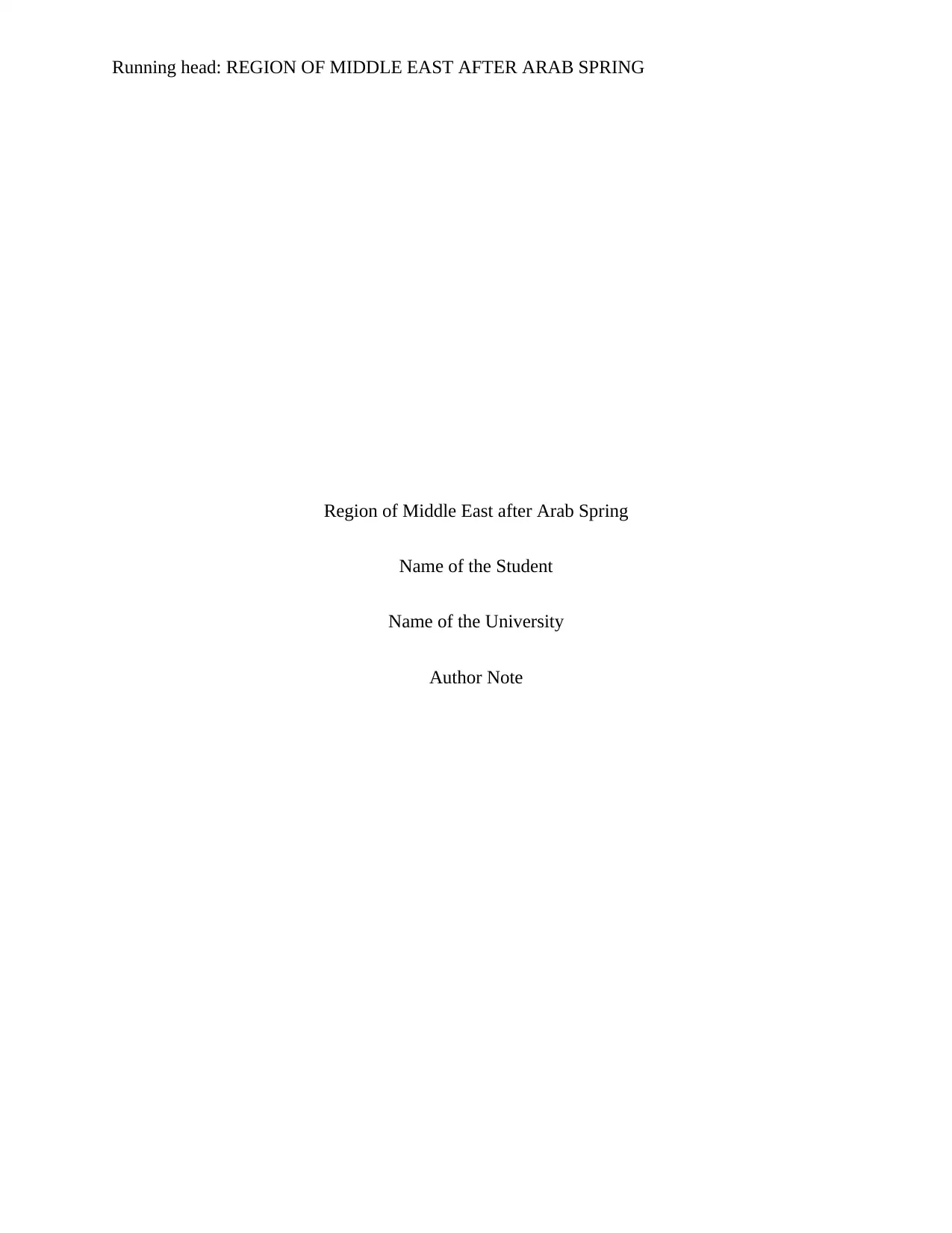
Running head: REGION OF MIDDLE EAST AFTER ARAB SPRING
Region of Middle East after Arab Spring
Name of the Student
Name of the University
Author Note
Region of Middle East after Arab Spring
Name of the Student
Name of the University
Author Note
Paraphrase This Document
Need a fresh take? Get an instant paraphrase of this document with our AI Paraphraser
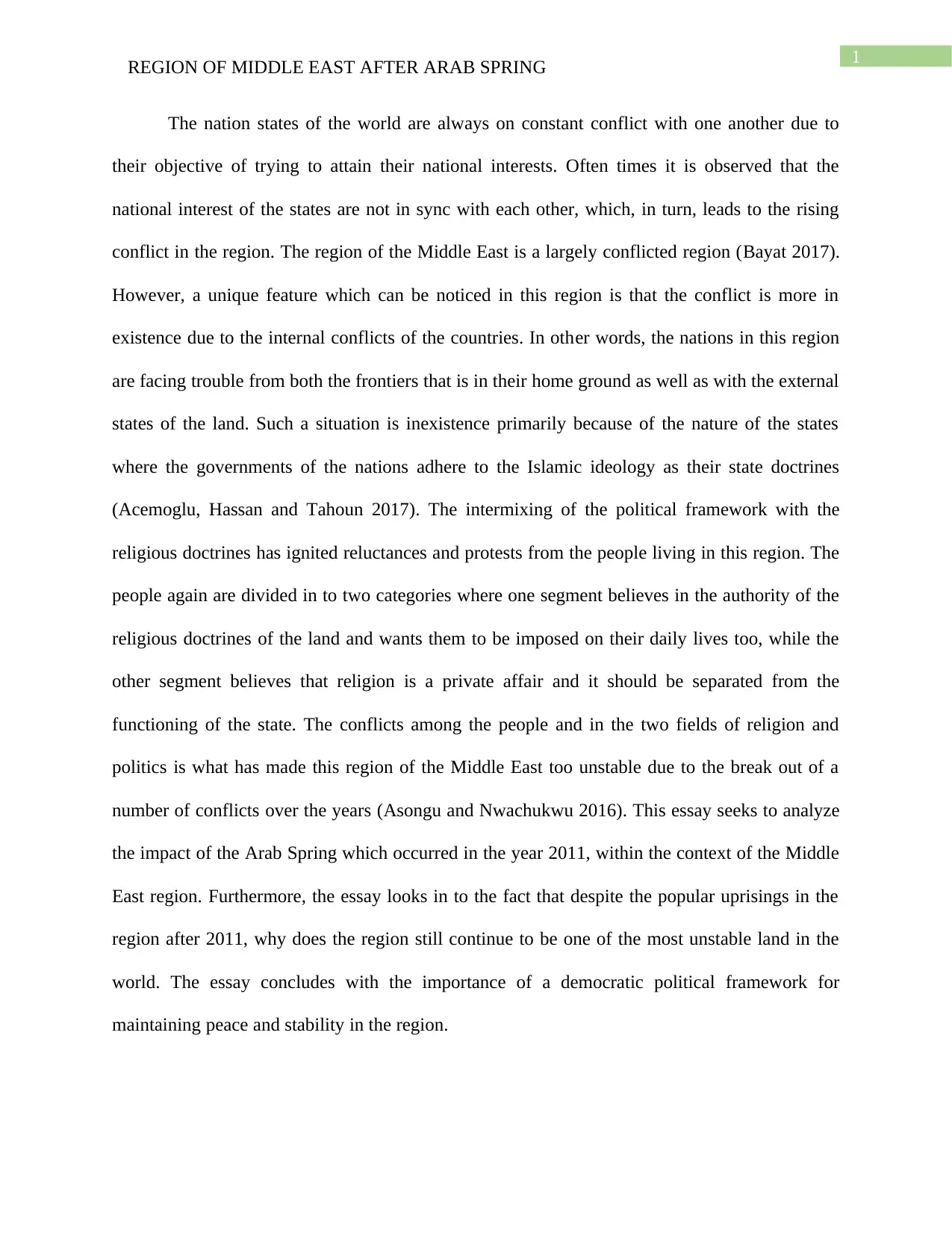
1
The nation states of the world are always on constant conflict with one another due to
their objective of trying to attain their national interests. Often times it is observed that the
national interest of the states are not in sync with each other, which, in turn, leads to the rising
conflict in the region. The region of the Middle East is a largely conflicted region (Bayat 2017).
However, a unique feature which can be noticed in this region is that the conflict is more in
existence due to the internal conflicts of the countries. In other words, the nations in this region
are facing trouble from both the frontiers that is in their home ground as well as with the external
states of the land. Such a situation is inexistence primarily because of the nature of the states
where the governments of the nations adhere to the Islamic ideology as their state doctrines
(Acemoglu, Hassan and Tahoun 2017). The intermixing of the political framework with the
religious doctrines has ignited reluctances and protests from the people living in this region. The
people again are divided in to two categories where one segment believes in the authority of the
religious doctrines of the land and wants them to be imposed on their daily lives too, while the
other segment believes that religion is a private affair and it should be separated from the
functioning of the state. The conflicts among the people and in the two fields of religion and
politics is what has made this region of the Middle East too unstable due to the break out of a
number of conflicts over the years (Asongu and Nwachukwu 2016). This essay seeks to analyze
the impact of the Arab Spring which occurred in the year 2011, within the context of the Middle
East region. Furthermore, the essay looks in to the fact that despite the popular uprisings in the
region after 2011, why does the region still continue to be one of the most unstable land in the
world. The essay concludes with the importance of a democratic political framework for
maintaining peace and stability in the region.
REGION OF MIDDLE EAST AFTER ARAB SPRING
The nation states of the world are always on constant conflict with one another due to
their objective of trying to attain their national interests. Often times it is observed that the
national interest of the states are not in sync with each other, which, in turn, leads to the rising
conflict in the region. The region of the Middle East is a largely conflicted region (Bayat 2017).
However, a unique feature which can be noticed in this region is that the conflict is more in
existence due to the internal conflicts of the countries. In other words, the nations in this region
are facing trouble from both the frontiers that is in their home ground as well as with the external
states of the land. Such a situation is inexistence primarily because of the nature of the states
where the governments of the nations adhere to the Islamic ideology as their state doctrines
(Acemoglu, Hassan and Tahoun 2017). The intermixing of the political framework with the
religious doctrines has ignited reluctances and protests from the people living in this region. The
people again are divided in to two categories where one segment believes in the authority of the
religious doctrines of the land and wants them to be imposed on their daily lives too, while the
other segment believes that religion is a private affair and it should be separated from the
functioning of the state. The conflicts among the people and in the two fields of religion and
politics is what has made this region of the Middle East too unstable due to the break out of a
number of conflicts over the years (Asongu and Nwachukwu 2016). This essay seeks to analyze
the impact of the Arab Spring which occurred in the year 2011, within the context of the Middle
East region. Furthermore, the essay looks in to the fact that despite the popular uprisings in the
region after 2011, why does the region still continue to be one of the most unstable land in the
world. The essay concludes with the importance of a democratic political framework for
maintaining peace and stability in the region.
REGION OF MIDDLE EAST AFTER ARAB SPRING
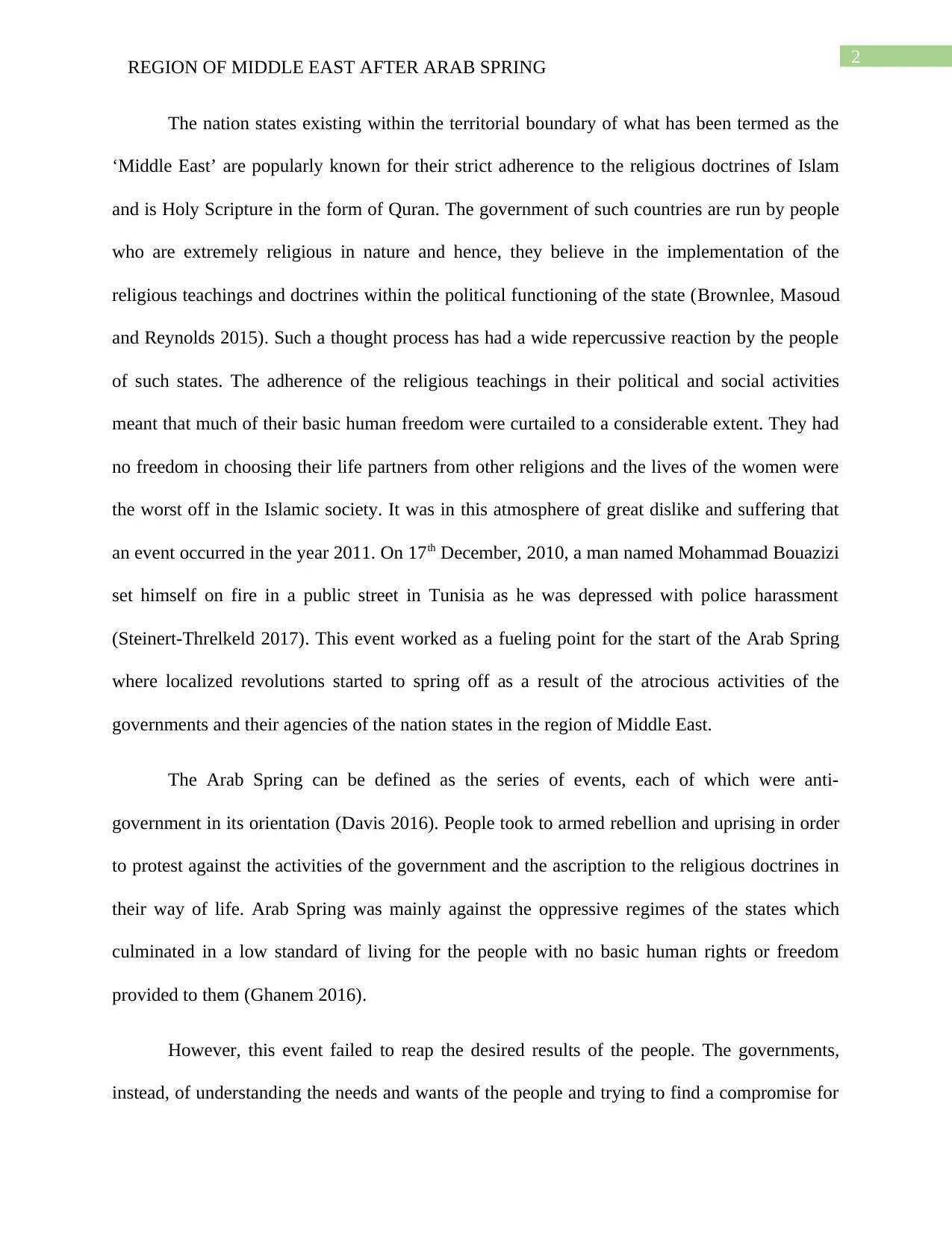
2
The nation states existing within the territorial boundary of what has been termed as the
‘Middle East’ are popularly known for their strict adherence to the religious doctrines of Islam
and is Holy Scripture in the form of Quran. The government of such countries are run by people
who are extremely religious in nature and hence, they believe in the implementation of the
religious teachings and doctrines within the political functioning of the state (Brownlee, Masoud
and Reynolds 2015). Such a thought process has had a wide repercussive reaction by the people
of such states. The adherence of the religious teachings in their political and social activities
meant that much of their basic human freedom were curtailed to a considerable extent. They had
no freedom in choosing their life partners from other religions and the lives of the women were
the worst off in the Islamic society. It was in this atmosphere of great dislike and suffering that
an event occurred in the year 2011. On 17th December, 2010, a man named Mohammad Bouazizi
set himself on fire in a public street in Tunisia as he was depressed with police harassment
(Steinert-Threlkeld 2017). This event worked as a fueling point for the start of the Arab Spring
where localized revolutions started to spring off as a result of the atrocious activities of the
governments and their agencies of the nation states in the region of Middle East.
The Arab Spring can be defined as the series of events, each of which were anti-
government in its orientation (Davis 2016). People took to armed rebellion and uprising in order
to protest against the activities of the government and the ascription to the religious doctrines in
their way of life. Arab Spring was mainly against the oppressive regimes of the states which
culminated in a low standard of living for the people with no basic human rights or freedom
provided to them (Ghanem 2016).
However, this event failed to reap the desired results of the people. The governments,
instead, of understanding the needs and wants of the people and trying to find a compromise for
REGION OF MIDDLE EAST AFTER ARAB SPRING
The nation states existing within the territorial boundary of what has been termed as the
‘Middle East’ are popularly known for their strict adherence to the religious doctrines of Islam
and is Holy Scripture in the form of Quran. The government of such countries are run by people
who are extremely religious in nature and hence, they believe in the implementation of the
religious teachings and doctrines within the political functioning of the state (Brownlee, Masoud
and Reynolds 2015). Such a thought process has had a wide repercussive reaction by the people
of such states. The adherence of the religious teachings in their political and social activities
meant that much of their basic human freedom were curtailed to a considerable extent. They had
no freedom in choosing their life partners from other religions and the lives of the women were
the worst off in the Islamic society. It was in this atmosphere of great dislike and suffering that
an event occurred in the year 2011. On 17th December, 2010, a man named Mohammad Bouazizi
set himself on fire in a public street in Tunisia as he was depressed with police harassment
(Steinert-Threlkeld 2017). This event worked as a fueling point for the start of the Arab Spring
where localized revolutions started to spring off as a result of the atrocious activities of the
governments and their agencies of the nation states in the region of Middle East.
The Arab Spring can be defined as the series of events, each of which were anti-
government in its orientation (Davis 2016). People took to armed rebellion and uprising in order
to protest against the activities of the government and the ascription to the religious doctrines in
their way of life. Arab Spring was mainly against the oppressive regimes of the states which
culminated in a low standard of living for the people with no basic human rights or freedom
provided to them (Ghanem 2016).
However, this event failed to reap the desired results of the people. The governments,
instead, of understanding the needs and wants of the people and trying to find a compromise for
REGION OF MIDDLE EAST AFTER ARAB SPRING
⊘ This is a preview!⊘
Do you want full access?
Subscribe today to unlock all pages.

Trusted by 1+ million students worldwide
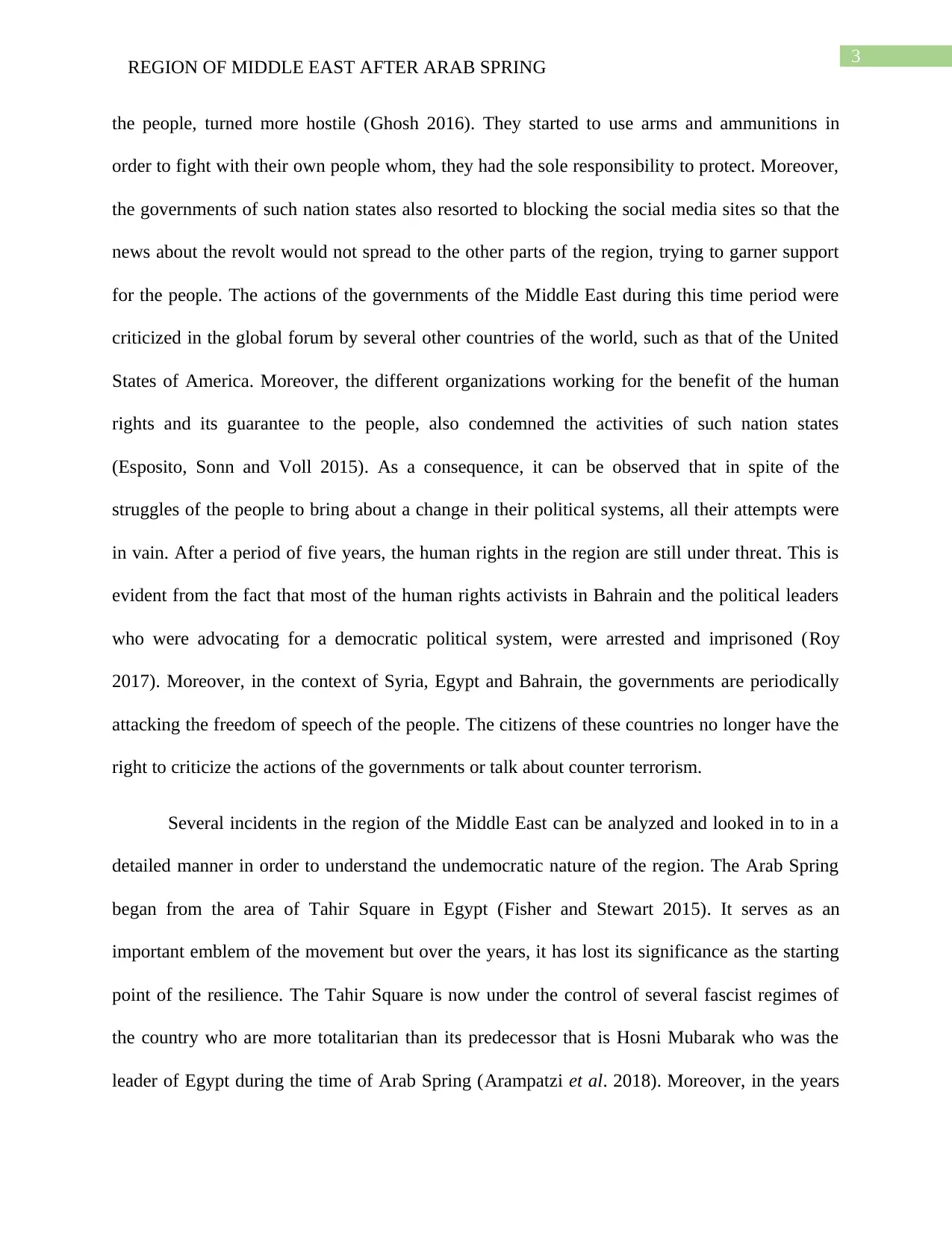
3
the people, turned more hostile (Ghosh 2016). They started to use arms and ammunitions in
order to fight with their own people whom, they had the sole responsibility to protect. Moreover,
the governments of such nation states also resorted to blocking the social media sites so that the
news about the revolt would not spread to the other parts of the region, trying to garner support
for the people. The actions of the governments of the Middle East during this time period were
criticized in the global forum by several other countries of the world, such as that of the United
States of America. Moreover, the different organizations working for the benefit of the human
rights and its guarantee to the people, also condemned the activities of such nation states
(Esposito, Sonn and Voll 2015). As a consequence, it can be observed that in spite of the
struggles of the people to bring about a change in their political systems, all their attempts were
in vain. After a period of five years, the human rights in the region are still under threat. This is
evident from the fact that most of the human rights activists in Bahrain and the political leaders
who were advocating for a democratic political system, were arrested and imprisoned (Roy
2017). Moreover, in the context of Syria, Egypt and Bahrain, the governments are periodically
attacking the freedom of speech of the people. The citizens of these countries no longer have the
right to criticize the actions of the governments or talk about counter terrorism.
Several incidents in the region of the Middle East can be analyzed and looked in to in a
detailed manner in order to understand the undemocratic nature of the region. The Arab Spring
began from the area of Tahir Square in Egypt (Fisher and Stewart 2015). It serves as an
important emblem of the movement but over the years, it has lost its significance as the starting
point of the resilience. The Tahir Square is now under the control of several fascist regimes of
the country who are more totalitarian than its predecessor that is Hosni Mubarak who was the
leader of Egypt during the time of Arab Spring (Arampatzi et al. 2018). Moreover, in the years
REGION OF MIDDLE EAST AFTER ARAB SPRING
the people, turned more hostile (Ghosh 2016). They started to use arms and ammunitions in
order to fight with their own people whom, they had the sole responsibility to protect. Moreover,
the governments of such nation states also resorted to blocking the social media sites so that the
news about the revolt would not spread to the other parts of the region, trying to garner support
for the people. The actions of the governments of the Middle East during this time period were
criticized in the global forum by several other countries of the world, such as that of the United
States of America. Moreover, the different organizations working for the benefit of the human
rights and its guarantee to the people, also condemned the activities of such nation states
(Esposito, Sonn and Voll 2015). As a consequence, it can be observed that in spite of the
struggles of the people to bring about a change in their political systems, all their attempts were
in vain. After a period of five years, the human rights in the region are still under threat. This is
evident from the fact that most of the human rights activists in Bahrain and the political leaders
who were advocating for a democratic political system, were arrested and imprisoned (Roy
2017). Moreover, in the context of Syria, Egypt and Bahrain, the governments are periodically
attacking the freedom of speech of the people. The citizens of these countries no longer have the
right to criticize the actions of the governments or talk about counter terrorism.
Several incidents in the region of the Middle East can be analyzed and looked in to in a
detailed manner in order to understand the undemocratic nature of the region. The Arab Spring
began from the area of Tahir Square in Egypt (Fisher and Stewart 2015). It serves as an
important emblem of the movement but over the years, it has lost its significance as the starting
point of the resilience. The Tahir Square is now under the control of several fascist regimes of
the country who are more totalitarian than its predecessor that is Hosni Mubarak who was the
leader of Egypt during the time of Arab Spring (Arampatzi et al. 2018). Moreover, in the years
REGION OF MIDDLE EAST AFTER ARAB SPRING
Paraphrase This Document
Need a fresh take? Get an instant paraphrase of this document with our AI Paraphraser
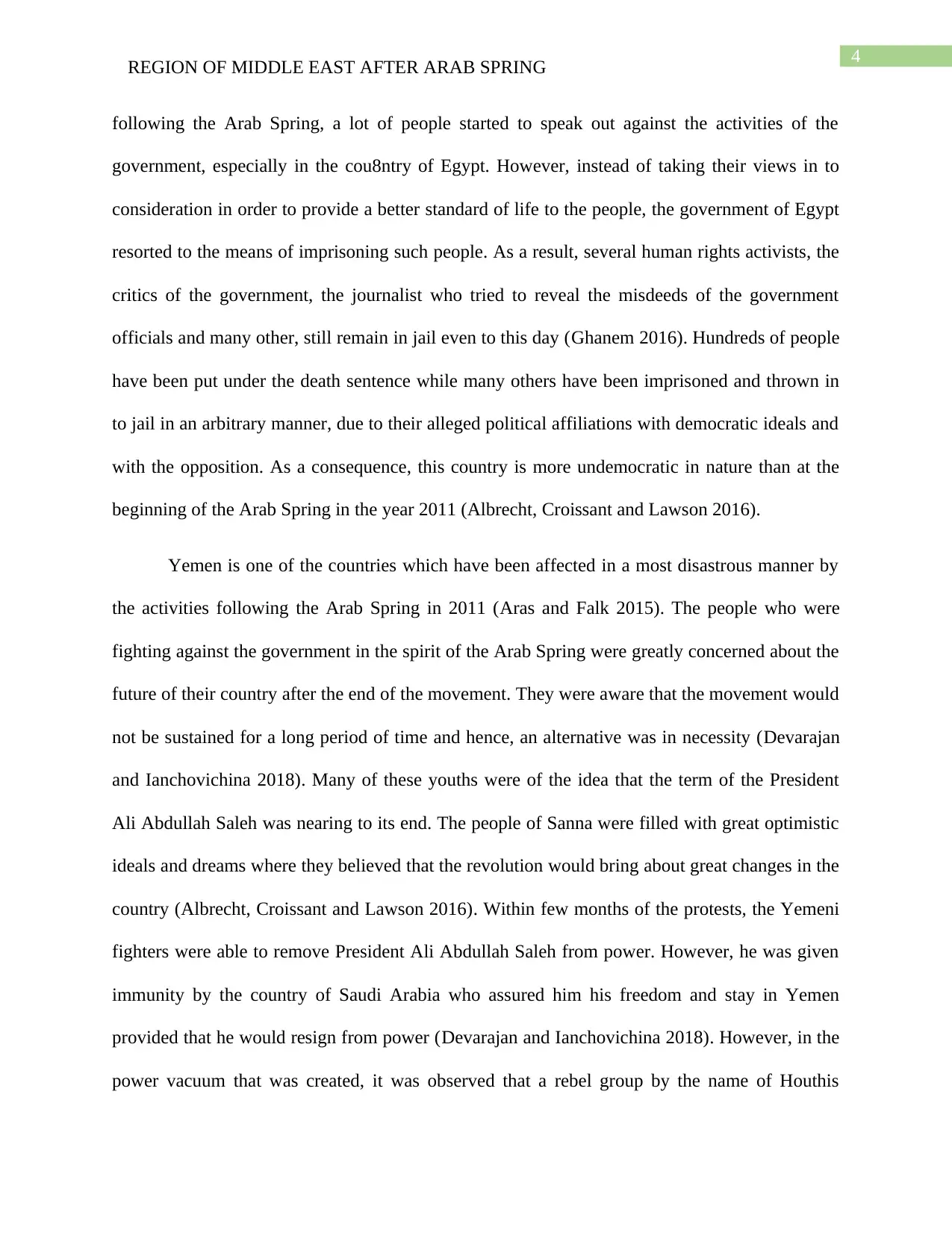
4
following the Arab Spring, a lot of people started to speak out against the activities of the
government, especially in the cou8ntry of Egypt. However, instead of taking their views in to
consideration in order to provide a better standard of life to the people, the government of Egypt
resorted to the means of imprisoning such people. As a result, several human rights activists, the
critics of the government, the journalist who tried to reveal the misdeeds of the government
officials and many other, still remain in jail even to this day (Ghanem 2016). Hundreds of people
have been put under the death sentence while many others have been imprisoned and thrown in
to jail in an arbitrary manner, due to their alleged political affiliations with democratic ideals and
with the opposition. As a consequence, this country is more undemocratic in nature than at the
beginning of the Arab Spring in the year 2011 (Albrecht, Croissant and Lawson 2016).
Yemen is one of the countries which have been affected in a most disastrous manner by
the activities following the Arab Spring in 2011 (Aras and Falk 2015). The people who were
fighting against the government in the spirit of the Arab Spring were greatly concerned about the
future of their country after the end of the movement. They were aware that the movement would
not be sustained for a long period of time and hence, an alternative was in necessity (Devarajan
and Ianchovichina 2018). Many of these youths were of the idea that the term of the President
Ali Abdullah Saleh was nearing to its end. The people of Sanna were filled with great optimistic
ideals and dreams where they believed that the revolution would bring about great changes in the
country (Albrecht, Croissant and Lawson 2016). Within few months of the protests, the Yemeni
fighters were able to remove President Ali Abdullah Saleh from power. However, he was given
immunity by the country of Saudi Arabia who assured him his freedom and stay in Yemen
provided that he would resign from power (Devarajan and Ianchovichina 2018). However, in the
power vacuum that was created, it was observed that a rebel group by the name of Houthis
REGION OF MIDDLE EAST AFTER ARAB SPRING
following the Arab Spring, a lot of people started to speak out against the activities of the
government, especially in the cou8ntry of Egypt. However, instead of taking their views in to
consideration in order to provide a better standard of life to the people, the government of Egypt
resorted to the means of imprisoning such people. As a result, several human rights activists, the
critics of the government, the journalist who tried to reveal the misdeeds of the government
officials and many other, still remain in jail even to this day (Ghanem 2016). Hundreds of people
have been put under the death sentence while many others have been imprisoned and thrown in
to jail in an arbitrary manner, due to their alleged political affiliations with democratic ideals and
with the opposition. As a consequence, this country is more undemocratic in nature than at the
beginning of the Arab Spring in the year 2011 (Albrecht, Croissant and Lawson 2016).
Yemen is one of the countries which have been affected in a most disastrous manner by
the activities following the Arab Spring in 2011 (Aras and Falk 2015). The people who were
fighting against the government in the spirit of the Arab Spring were greatly concerned about the
future of their country after the end of the movement. They were aware that the movement would
not be sustained for a long period of time and hence, an alternative was in necessity (Devarajan
and Ianchovichina 2018). Many of these youths were of the idea that the term of the President
Ali Abdullah Saleh was nearing to its end. The people of Sanna were filled with great optimistic
ideals and dreams where they believed that the revolution would bring about great changes in the
country (Albrecht, Croissant and Lawson 2016). Within few months of the protests, the Yemeni
fighters were able to remove President Ali Abdullah Saleh from power. However, he was given
immunity by the country of Saudi Arabia who assured him his freedom and stay in Yemen
provided that he would resign from power (Devarajan and Ianchovichina 2018). However, in the
power vacuum that was created, it was observed that a rebel group by the name of Houthis
REGION OF MIDDLE EAST AFTER ARAB SPRING
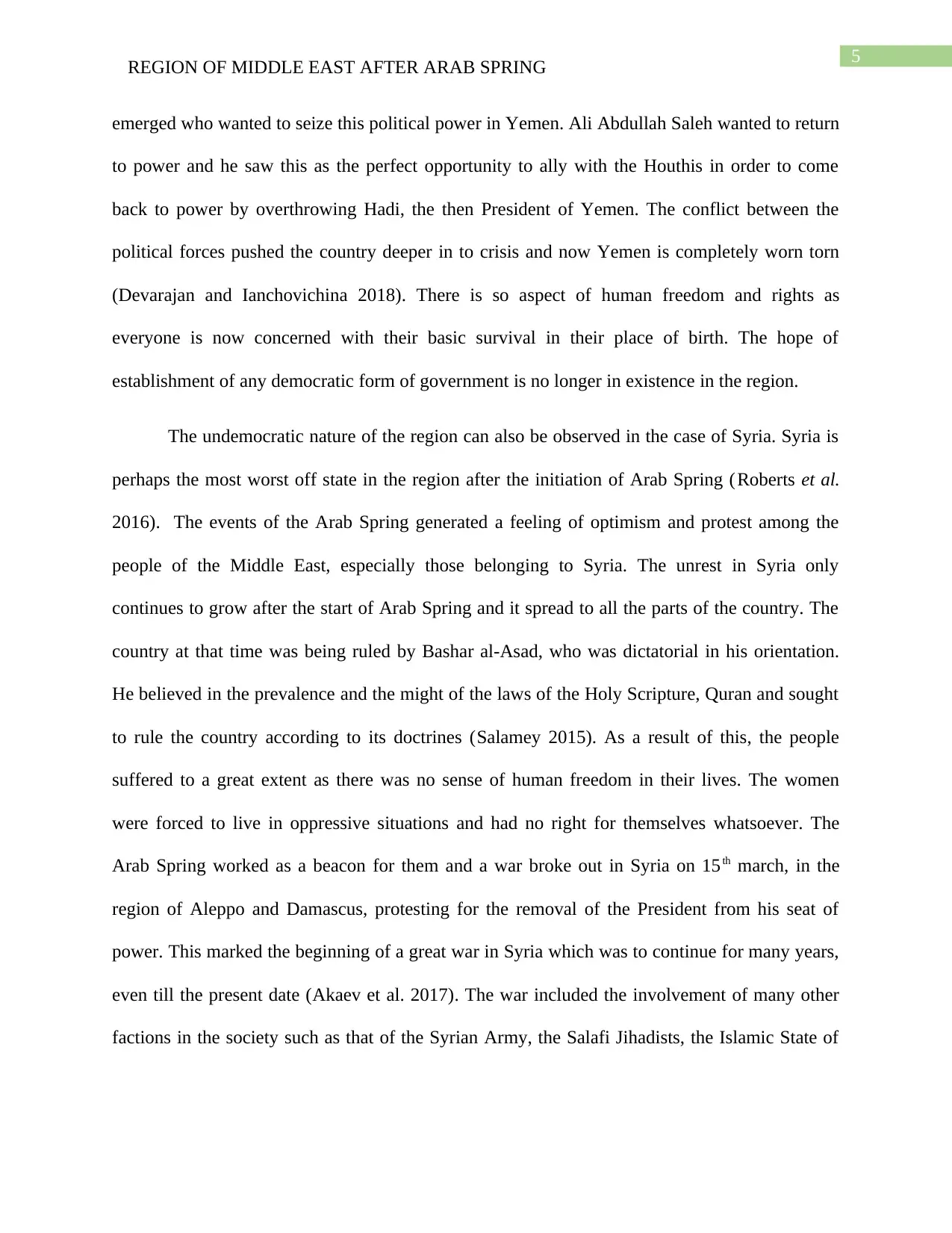
5
emerged who wanted to seize this political power in Yemen. Ali Abdullah Saleh wanted to return
to power and he saw this as the perfect opportunity to ally with the Houthis in order to come
back to power by overthrowing Hadi, the then President of Yemen. The conflict between the
political forces pushed the country deeper in to crisis and now Yemen is completely worn torn
(Devarajan and Ianchovichina 2018). There is so aspect of human freedom and rights as
everyone is now concerned with their basic survival in their place of birth. The hope of
establishment of any democratic form of government is no longer in existence in the region.
The undemocratic nature of the region can also be observed in the case of Syria. Syria is
perhaps the most worst off state in the region after the initiation of Arab Spring (Roberts et al.
2016). The events of the Arab Spring generated a feeling of optimism and protest among the
people of the Middle East, especially those belonging to Syria. The unrest in Syria only
continues to grow after the start of Arab Spring and it spread to all the parts of the country. The
country at that time was being ruled by Bashar al-Asad, who was dictatorial in his orientation.
He believed in the prevalence and the might of the laws of the Holy Scripture, Quran and sought
to rule the country according to its doctrines (Salamey 2015). As a result of this, the people
suffered to a great extent as there was no sense of human freedom in their lives. The women
were forced to live in oppressive situations and had no right for themselves whatsoever. The
Arab Spring worked as a beacon for them and a war broke out in Syria on 15th march, in the
region of Aleppo and Damascus, protesting for the removal of the President from his seat of
power. This marked the beginning of a great war in Syria which was to continue for many years,
even till the present date (Akaev et al. 2017). The war included the involvement of many other
factions in the society such as that of the Syrian Army, the Salafi Jihadists, the Islamic State of
REGION OF MIDDLE EAST AFTER ARAB SPRING
emerged who wanted to seize this political power in Yemen. Ali Abdullah Saleh wanted to return
to power and he saw this as the perfect opportunity to ally with the Houthis in order to come
back to power by overthrowing Hadi, the then President of Yemen. The conflict between the
political forces pushed the country deeper in to crisis and now Yemen is completely worn torn
(Devarajan and Ianchovichina 2018). There is so aspect of human freedom and rights as
everyone is now concerned with their basic survival in their place of birth. The hope of
establishment of any democratic form of government is no longer in existence in the region.
The undemocratic nature of the region can also be observed in the case of Syria. Syria is
perhaps the most worst off state in the region after the initiation of Arab Spring (Roberts et al.
2016). The events of the Arab Spring generated a feeling of optimism and protest among the
people of the Middle East, especially those belonging to Syria. The unrest in Syria only
continues to grow after the start of Arab Spring and it spread to all the parts of the country. The
country at that time was being ruled by Bashar al-Asad, who was dictatorial in his orientation.
He believed in the prevalence and the might of the laws of the Holy Scripture, Quran and sought
to rule the country according to its doctrines (Salamey 2015). As a result of this, the people
suffered to a great extent as there was no sense of human freedom in their lives. The women
were forced to live in oppressive situations and had no right for themselves whatsoever. The
Arab Spring worked as a beacon for them and a war broke out in Syria on 15th march, in the
region of Aleppo and Damascus, protesting for the removal of the President from his seat of
power. This marked the beginning of a great war in Syria which was to continue for many years,
even till the present date (Akaev et al. 2017). The war included the involvement of many other
factions in the society such as that of the Syrian Army, the Salafi Jihadists, the Islamic State of
REGION OF MIDDLE EAST AFTER ARAB SPRING
⊘ This is a preview!⊘
Do you want full access?
Subscribe today to unlock all pages.

Trusted by 1+ million students worldwide
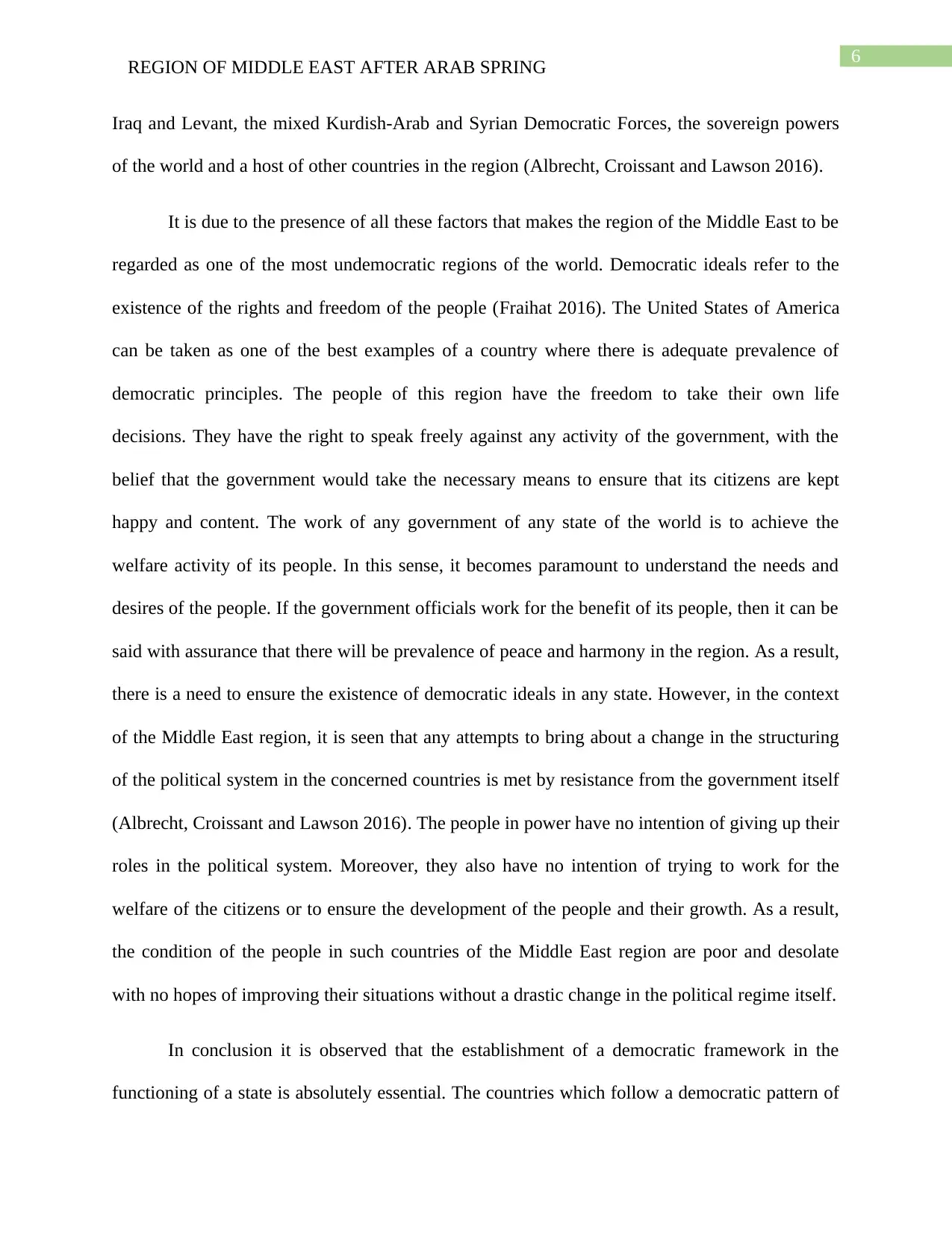
6
Iraq and Levant, the mixed Kurdish-Arab and Syrian Democratic Forces, the sovereign powers
of the world and a host of other countries in the region (Albrecht, Croissant and Lawson 2016).
It is due to the presence of all these factors that makes the region of the Middle East to be
regarded as one of the most undemocratic regions of the world. Democratic ideals refer to the
existence of the rights and freedom of the people (Fraihat 2016). The United States of America
can be taken as one of the best examples of a country where there is adequate prevalence of
democratic principles. The people of this region have the freedom to take their own life
decisions. They have the right to speak freely against any activity of the government, with the
belief that the government would take the necessary means to ensure that its citizens are kept
happy and content. The work of any government of any state of the world is to achieve the
welfare activity of its people. In this sense, it becomes paramount to understand the needs and
desires of the people. If the government officials work for the benefit of its people, then it can be
said with assurance that there will be prevalence of peace and harmony in the region. As a result,
there is a need to ensure the existence of democratic ideals in any state. However, in the context
of the Middle East region, it is seen that any attempts to bring about a change in the structuring
of the political system in the concerned countries is met by resistance from the government itself
(Albrecht, Croissant and Lawson 2016). The people in power have no intention of giving up their
roles in the political system. Moreover, they also have no intention of trying to work for the
welfare of the citizens or to ensure the development of the people and their growth. As a result,
the condition of the people in such countries of the Middle East region are poor and desolate
with no hopes of improving their situations without a drastic change in the political regime itself.
In conclusion it is observed that the establishment of a democratic framework in the
functioning of a state is absolutely essential. The countries which follow a democratic pattern of
REGION OF MIDDLE EAST AFTER ARAB SPRING
Iraq and Levant, the mixed Kurdish-Arab and Syrian Democratic Forces, the sovereign powers
of the world and a host of other countries in the region (Albrecht, Croissant and Lawson 2016).
It is due to the presence of all these factors that makes the region of the Middle East to be
regarded as one of the most undemocratic regions of the world. Democratic ideals refer to the
existence of the rights and freedom of the people (Fraihat 2016). The United States of America
can be taken as one of the best examples of a country where there is adequate prevalence of
democratic principles. The people of this region have the freedom to take their own life
decisions. They have the right to speak freely against any activity of the government, with the
belief that the government would take the necessary means to ensure that its citizens are kept
happy and content. The work of any government of any state of the world is to achieve the
welfare activity of its people. In this sense, it becomes paramount to understand the needs and
desires of the people. If the government officials work for the benefit of its people, then it can be
said with assurance that there will be prevalence of peace and harmony in the region. As a result,
there is a need to ensure the existence of democratic ideals in any state. However, in the context
of the Middle East region, it is seen that any attempts to bring about a change in the structuring
of the political system in the concerned countries is met by resistance from the government itself
(Albrecht, Croissant and Lawson 2016). The people in power have no intention of giving up their
roles in the political system. Moreover, they also have no intention of trying to work for the
welfare of the citizens or to ensure the development of the people and their growth. As a result,
the condition of the people in such countries of the Middle East region are poor and desolate
with no hopes of improving their situations without a drastic change in the political regime itself.
In conclusion it is observed that the establishment of a democratic framework in the
functioning of a state is absolutely essential. The countries which follow a democratic pattern of
REGION OF MIDDLE EAST AFTER ARAB SPRING
Paraphrase This Document
Need a fresh take? Get an instant paraphrase of this document with our AI Paraphraser
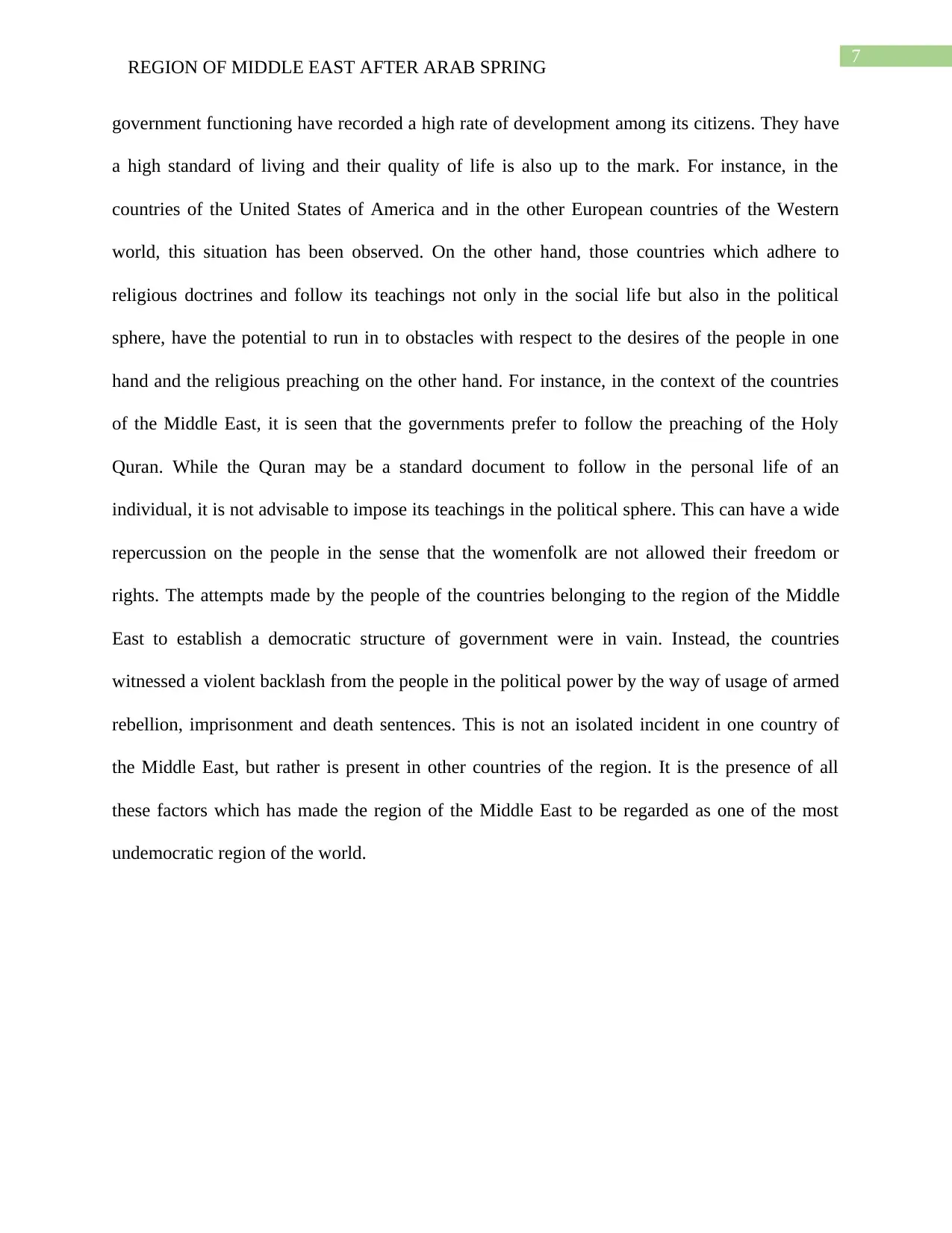
7
government functioning have recorded a high rate of development among its citizens. They have
a high standard of living and their quality of life is also up to the mark. For instance, in the
countries of the United States of America and in the other European countries of the Western
world, this situation has been observed. On the other hand, those countries which adhere to
religious doctrines and follow its teachings not only in the social life but also in the political
sphere, have the potential to run in to obstacles with respect to the desires of the people in one
hand and the religious preaching on the other hand. For instance, in the context of the countries
of the Middle East, it is seen that the governments prefer to follow the preaching of the Holy
Quran. While the Quran may be a standard document to follow in the personal life of an
individual, it is not advisable to impose its teachings in the political sphere. This can have a wide
repercussion on the people in the sense that the womenfolk are not allowed their freedom or
rights. The attempts made by the people of the countries belonging to the region of the Middle
East to establish a democratic structure of government were in vain. Instead, the countries
witnessed a violent backlash from the people in the political power by the way of usage of armed
rebellion, imprisonment and death sentences. This is not an isolated incident in one country of
the Middle East, but rather is present in other countries of the region. It is the presence of all
these factors which has made the region of the Middle East to be regarded as one of the most
undemocratic region of the world.
REGION OF MIDDLE EAST AFTER ARAB SPRING
government functioning have recorded a high rate of development among its citizens. They have
a high standard of living and their quality of life is also up to the mark. For instance, in the
countries of the United States of America and in the other European countries of the Western
world, this situation has been observed. On the other hand, those countries which adhere to
religious doctrines and follow its teachings not only in the social life but also in the political
sphere, have the potential to run in to obstacles with respect to the desires of the people in one
hand and the religious preaching on the other hand. For instance, in the context of the countries
of the Middle East, it is seen that the governments prefer to follow the preaching of the Holy
Quran. While the Quran may be a standard document to follow in the personal life of an
individual, it is not advisable to impose its teachings in the political sphere. This can have a wide
repercussion on the people in the sense that the womenfolk are not allowed their freedom or
rights. The attempts made by the people of the countries belonging to the region of the Middle
East to establish a democratic structure of government were in vain. Instead, the countries
witnessed a violent backlash from the people in the political power by the way of usage of armed
rebellion, imprisonment and death sentences. This is not an isolated incident in one country of
the Middle East, but rather is present in other countries of the region. It is the presence of all
these factors which has made the region of the Middle East to be regarded as one of the most
undemocratic region of the world.
REGION OF MIDDLE EAST AFTER ARAB SPRING
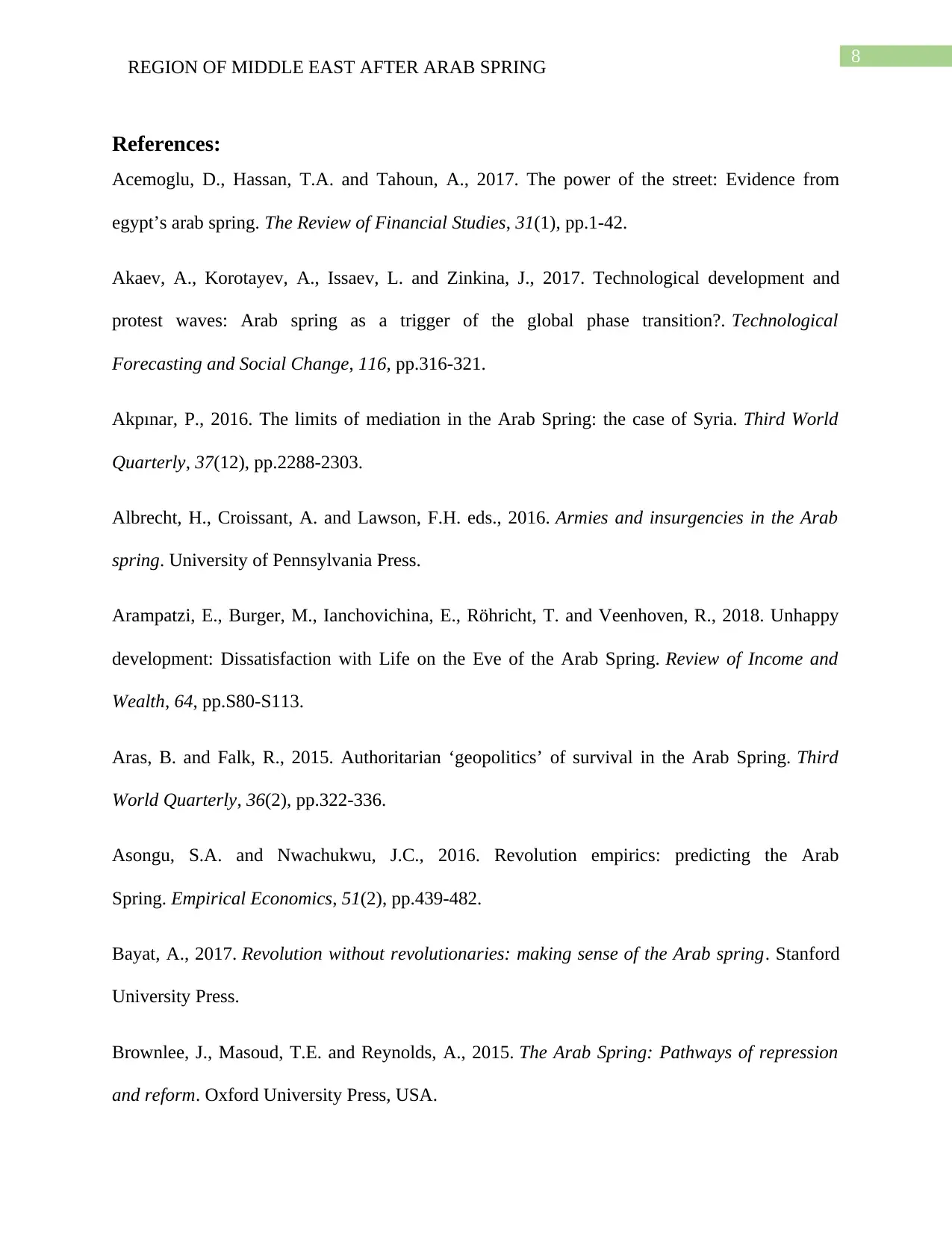
8
References:
Acemoglu, D., Hassan, T.A. and Tahoun, A., 2017. The power of the street: Evidence from
egypt’s arab spring. The Review of Financial Studies, 31(1), pp.1-42.
Akaev, A., Korotayev, A., Issaev, L. and Zinkina, J., 2017. Technological development and
protest waves: Arab spring as a trigger of the global phase transition?. Technological
Forecasting and Social Change, 116, pp.316-321.
Akpınar, P., 2016. The limits of mediation in the Arab Spring: the case of Syria. Third World
Quarterly, 37(12), pp.2288-2303.
Albrecht, H., Croissant, A. and Lawson, F.H. eds., 2016. Armies and insurgencies in the Arab
spring. University of Pennsylvania Press.
Arampatzi, E., Burger, M., Ianchovichina, E., Röhricht, T. and Veenhoven, R., 2018. Unhappy
development: Dissatisfaction with Life on the Eve of the Arab Spring. Review of Income and
Wealth, 64, pp.S80-S113.
Aras, B. and Falk, R., 2015. Authoritarian ‘geopolitics’ of survival in the Arab Spring. Third
World Quarterly, 36(2), pp.322-336.
Asongu, S.A. and Nwachukwu, J.C., 2016. Revolution empirics: predicting the Arab
Spring. Empirical Economics, 51(2), pp.439-482.
Bayat, A., 2017. Revolution without revolutionaries: making sense of the Arab spring. Stanford
University Press.
Brownlee, J., Masoud, T.E. and Reynolds, A., 2015. The Arab Spring: Pathways of repression
and reform. Oxford University Press, USA.
REGION OF MIDDLE EAST AFTER ARAB SPRING
References:
Acemoglu, D., Hassan, T.A. and Tahoun, A., 2017. The power of the street: Evidence from
egypt’s arab spring. The Review of Financial Studies, 31(1), pp.1-42.
Akaev, A., Korotayev, A., Issaev, L. and Zinkina, J., 2017. Technological development and
protest waves: Arab spring as a trigger of the global phase transition?. Technological
Forecasting and Social Change, 116, pp.316-321.
Akpınar, P., 2016. The limits of mediation in the Arab Spring: the case of Syria. Third World
Quarterly, 37(12), pp.2288-2303.
Albrecht, H., Croissant, A. and Lawson, F.H. eds., 2016. Armies and insurgencies in the Arab
spring. University of Pennsylvania Press.
Arampatzi, E., Burger, M., Ianchovichina, E., Röhricht, T. and Veenhoven, R., 2018. Unhappy
development: Dissatisfaction with Life on the Eve of the Arab Spring. Review of Income and
Wealth, 64, pp.S80-S113.
Aras, B. and Falk, R., 2015. Authoritarian ‘geopolitics’ of survival in the Arab Spring. Third
World Quarterly, 36(2), pp.322-336.
Asongu, S.A. and Nwachukwu, J.C., 2016. Revolution empirics: predicting the Arab
Spring. Empirical Economics, 51(2), pp.439-482.
Bayat, A., 2017. Revolution without revolutionaries: making sense of the Arab spring. Stanford
University Press.
Brownlee, J., Masoud, T.E. and Reynolds, A., 2015. The Arab Spring: Pathways of repression
and reform. Oxford University Press, USA.
REGION OF MIDDLE EAST AFTER ARAB SPRING
⊘ This is a preview!⊘
Do you want full access?
Subscribe today to unlock all pages.

Trusted by 1+ million students worldwide
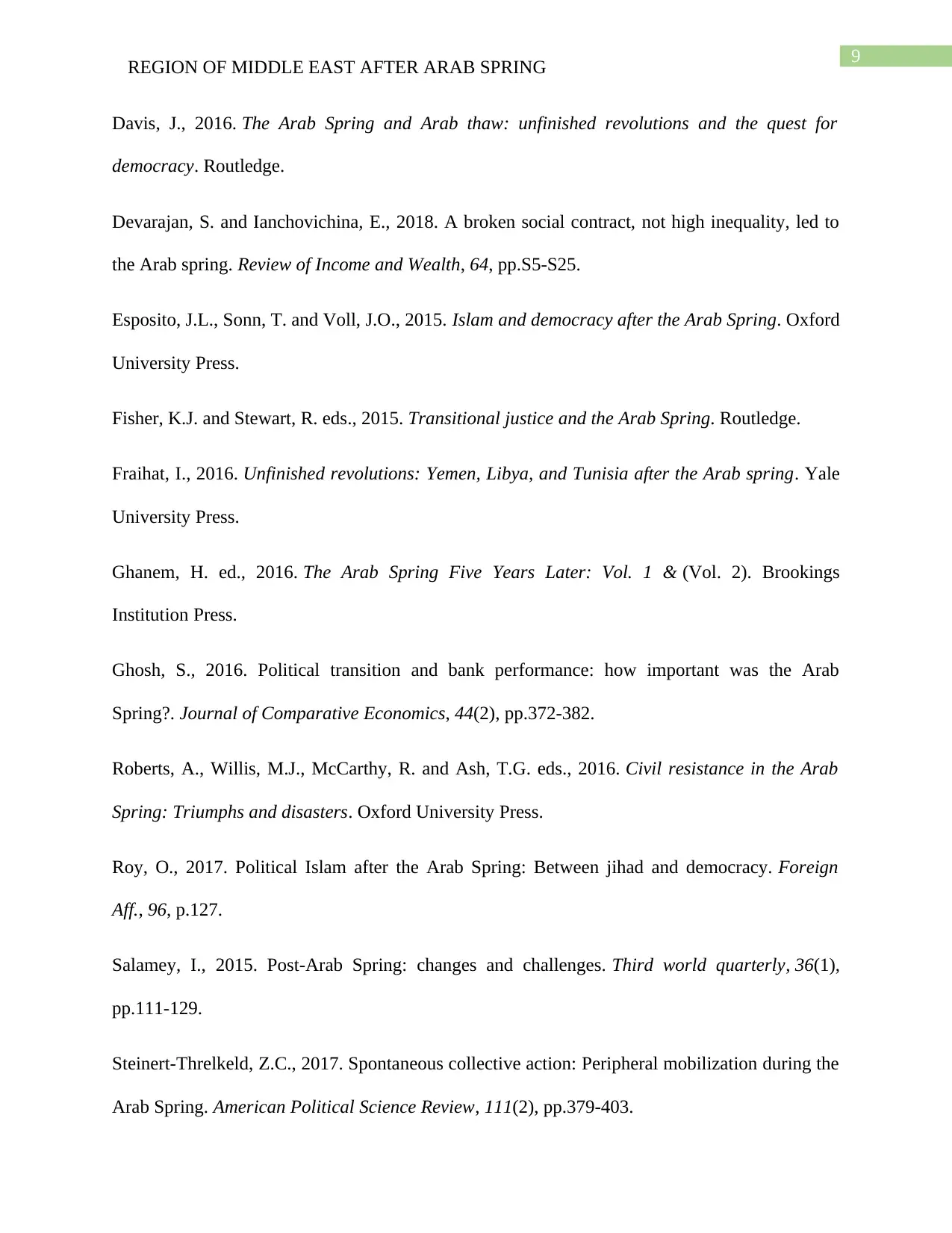
9
Davis, J., 2016. The Arab Spring and Arab thaw: unfinished revolutions and the quest for
democracy. Routledge.
Devarajan, S. and Ianchovichina, E., 2018. A broken social contract, not high inequality, led to
the Arab spring. Review of Income and Wealth, 64, pp.S5-S25.
Esposito, J.L., Sonn, T. and Voll, J.O., 2015. Islam and democracy after the Arab Spring. Oxford
University Press.
Fisher, K.J. and Stewart, R. eds., 2015. Transitional justice and the Arab Spring. Routledge.
Fraihat, I., 2016. Unfinished revolutions: Yemen, Libya, and Tunisia after the Arab spring. Yale
University Press.
Ghanem, H. ed., 2016. The Arab Spring Five Years Later: Vol. 1 & (Vol. 2). Brookings
Institution Press.
Ghosh, S., 2016. Political transition and bank performance: how important was the Arab
Spring?. Journal of Comparative Economics, 44(2), pp.372-382.
Roberts, A., Willis, M.J., McCarthy, R. and Ash, T.G. eds., 2016. Civil resistance in the Arab
Spring: Triumphs and disasters. Oxford University Press.
Roy, O., 2017. Political Islam after the Arab Spring: Between jihad and democracy. Foreign
Aff., 96, p.127.
Salamey, I., 2015. Post-Arab Spring: changes and challenges. Third world quarterly, 36(1),
pp.111-129.
Steinert-Threlkeld, Z.C., 2017. Spontaneous collective action: Peripheral mobilization during the
Arab Spring. American Political Science Review, 111(2), pp.379-403.
REGION OF MIDDLE EAST AFTER ARAB SPRING
Davis, J., 2016. The Arab Spring and Arab thaw: unfinished revolutions and the quest for
democracy. Routledge.
Devarajan, S. and Ianchovichina, E., 2018. A broken social contract, not high inequality, led to
the Arab spring. Review of Income and Wealth, 64, pp.S5-S25.
Esposito, J.L., Sonn, T. and Voll, J.O., 2015. Islam and democracy after the Arab Spring. Oxford
University Press.
Fisher, K.J. and Stewart, R. eds., 2015. Transitional justice and the Arab Spring. Routledge.
Fraihat, I., 2016. Unfinished revolutions: Yemen, Libya, and Tunisia after the Arab spring. Yale
University Press.
Ghanem, H. ed., 2016. The Arab Spring Five Years Later: Vol. 1 & (Vol. 2). Brookings
Institution Press.
Ghosh, S., 2016. Political transition and bank performance: how important was the Arab
Spring?. Journal of Comparative Economics, 44(2), pp.372-382.
Roberts, A., Willis, M.J., McCarthy, R. and Ash, T.G. eds., 2016. Civil resistance in the Arab
Spring: Triumphs and disasters. Oxford University Press.
Roy, O., 2017. Political Islam after the Arab Spring: Between jihad and democracy. Foreign
Aff., 96, p.127.
Salamey, I., 2015. Post-Arab Spring: changes and challenges. Third world quarterly, 36(1),
pp.111-129.
Steinert-Threlkeld, Z.C., 2017. Spontaneous collective action: Peripheral mobilization during the
Arab Spring. American Political Science Review, 111(2), pp.379-403.
REGION OF MIDDLE EAST AFTER ARAB SPRING
Paraphrase This Document
Need a fresh take? Get an instant paraphrase of this document with our AI Paraphraser

10
REGION OF MIDDLE EAST AFTER ARAB SPRING
REGION OF MIDDLE EAST AFTER ARAB SPRING
1 out of 11
Related Documents
Your All-in-One AI-Powered Toolkit for Academic Success.
+13062052269
info@desklib.com
Available 24*7 on WhatsApp / Email
![[object Object]](/_next/static/media/star-bottom.7253800d.svg)
Unlock your academic potential
Copyright © 2020–2025 A2Z Services. All Rights Reserved. Developed and managed by ZUCOL.





